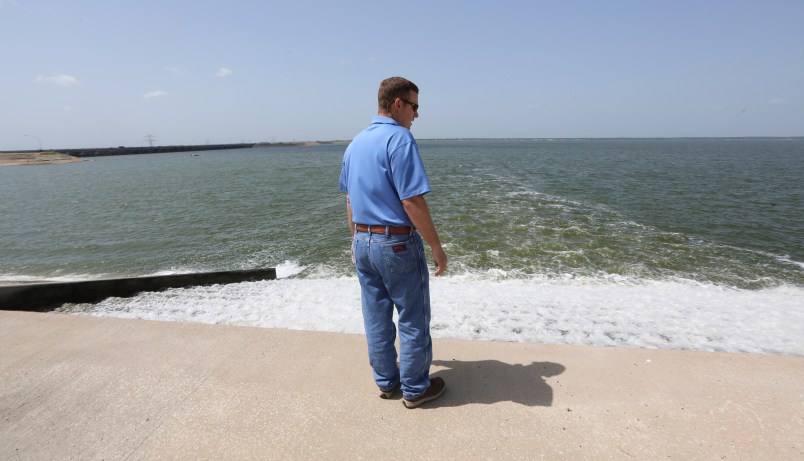FAIRFIELD, Texas (AP) — As murky water snakes through a man-made wetland between Dallas and Houston, its shallow ponds of lush vegetation slowly filter out phosphorous and nitrates until, a week later, the water runs clear as a creek into the area drinking supply.
The 2,000-acre wetland system in Fairfield converts what is mainly treated wastewater that would otherwise flow into the Gulf of Mexico into an additional 65,000 gallons per day feeding the Richland-Chambers Reservoir — a significant contribution in a state enduring prolonged drought.
At $75 million, the wetlands system cost far less to build than traditional filtering infrastructure and has piqued the interest of planners from places as far afield as Mexico City and Baghdad, where bombs destroyed the water infrastructure. And with climatologists predicting longer and more frequent droughts worldwide, the wetland system greatly reduces the pressure on water utilities and their reliance on precipitation.
“This is stepping back from dependence on rainfall,” said David Marshall, head of engineering services for Tarrant Regional Water District, which operates the wetlands. “With potential climate change or long-term droughts, we’re at risk, whereas these wetlands firm up a tremendous amount of water supply for us.”
The technology behind the George Shannon Wetland Water Reuse Project has been around for decades, but only recently proved reliable and cost efficient.
It reroutes Trinity River water — which in July was mostly treated wastewater that entered the waterway 100 miles upstream — into large pools where the sediment settles, Darrel Andrews, the water district’s environmental director, said. From there, it passes through areas abundant with ragweed, hackberry and other plants where many water birds roost. Along the way, microbes and plants filter out the nitrates and phosphorous from the water, which is eventually released into the reservoir.
The George Shannon wetland, which was built over a former Texaco oil field, provides about 30 percent more water to the reservoir than it would otherwise hold — a boon to its 1.5 million users in North Texas.
Although the Fairfield wetland is a hedge against climate change and more frequent dry spells, communities elsewhere in the U.S. have been turning to wetlands for ecological solutions to other problems.
For example, Bloomington, Illinois, is using man-made wetlands to address water quality, not quantity. The community has long struggled with potentially hazardous levels of nitrates in its public drinking supply. So it turned to farmers, whose fertilizer-laden fields helped create the problem, for help.
John Franklin’s family has been farming in the small, agricultural community of Lexington, two hours south of Chicago, since 1848. Their land sits in the watershed that feeds one of Bloomington’s reservoirs.
The area was once covered in marshes and wetlands, and was too wet to effectively farm. So Franklin’s ancestors and others found the only way to make the land productive was to quickly drain excess water.
But after more than a century of bountiful corn and soybean crops, high levels of nitrates, which can cause oxygen deficiencies in infants and “dead zones” in bodies of water where nothing can live, have been found in municipal drinking supplies.
Rick Twait, Bloomington’s superintendent of water purification, and other officials decided to focus on the 72,000 acres of watersheds that feed the city’s two existing reservoirs. Working with The Nature Conservancy, the University of Illinois and others, wetlands of various sizes were placed in farming fields — including Franklin’s.
The goal was to reduce nitrates by 50 percent. Ten years later, the numbers are encouraging and doable: only about 2.6 percent to 3 percent of an agricultural field needs to be wetlands to achieve effective filtration, said Maria Lemke, an aquatic ecologist with the conservancy who oversees the research.
Franklin received federal funding to transform part of his family’s 1,200-acre farm into a wetland.
“It had to be done. We’re all in the same watershed. Everything we do upstream affects everybody downstream,” he said.
But with corn and soybean crops fetching record prices, it has been difficult to find others willing to take land out of production. A few, though, are participating and once there are enough wetlands, the city will have a natural filter that doesn’t require energy to operate and needs minimal maintenance, Twait said.
“It’s basically on call all the time,” he said.
___
Plushnick-Masti reported from Houston.
___
Follow Schmall on Twitter at https://twitter.com/emilyschmall and Plushnick-Masti at https://twitter.com/RamitMastiAP
Copyright 2014 The Associated Press. All rights reserved. This material may not be published, broadcast, rewritten or redistributed.







Not the first, just the latest to do this.
Arcata, California began doing this back in the 1970’s.
Here is a link to an EPA report published in the 90’s.
San Diego pumps millions of gallons of treated wastewater into the ocean. Every day.
180 million gallons.
Every day.
It’s not drinkable, but if you treated it through some kind of wetland filtering system like, I dunno, a river, and pump it into a reservoir for holding for later treatment into potability it might make sense.
[http://www.sandiego.gov/mwwd/facilities/ptloma/][Point Loma Treatment Plant]
Try that again:
www.sandiego.gov/mwwd/facilities/ptloma/